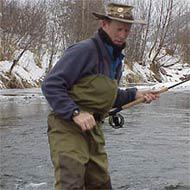
This year it has been especially wet with heavy rainfalls especially here in the south. We in Charlotte have experienced dangerous flooding in July which is usually a very dry month. This is a good time to discuss some of the best tips for safely wading the swollen streams; in fact these tips are good at any time. Here are my five best tips:
1. Wear proper wading shoes. The best from my point of view is the felt soled boots. However, where rocks are a factor, anglers often prefer rubber boots with studs. This is a better option if there is reason to suspect any aquatic nuisances.
2. Always use a wading staff which is indispensable especially when wading conditions are difficult. A wading staff allows you to have two points of contact when one foot is lifted to make a step. If you don’t have one, a great strong, light staff can be made from bamboo and when all else fails use a stick.
3. Never neglect to use your wading belt. In the event of a fall, it will slow the inflow of water into your waders preventing them from getting heavy making it harder to get up and exit the stream. Remember to let the water out of the upper half of your waders as soon as you stand up, preventing all of it to drain into the bottom half of the waders. Another advantage of using a belt on the waders is that it will trap some air in the waders allowing them to be buoyant.
4. Always stand firm with the legs spread apart as much as practical and flex your knees similar to down hill skiing. This gives you better balance and control. Of course, foot placement is very important. If necessary, nestle or rub your foot over the gravel or stones to be certain that you are in a solid spot. Do not place your foot unless you can see the bottom.
5. Select your best location to cross a stream which is usually at the tail of a pool or at the head of a wide riffle. When crossing a stream always work slightly upward facing the current and you will be able to avoid being pushed into a hole. When turning around in a strong current, always pivot upstream against current. Do not let yourself get too tired so it may be necessary to stop to rest.





